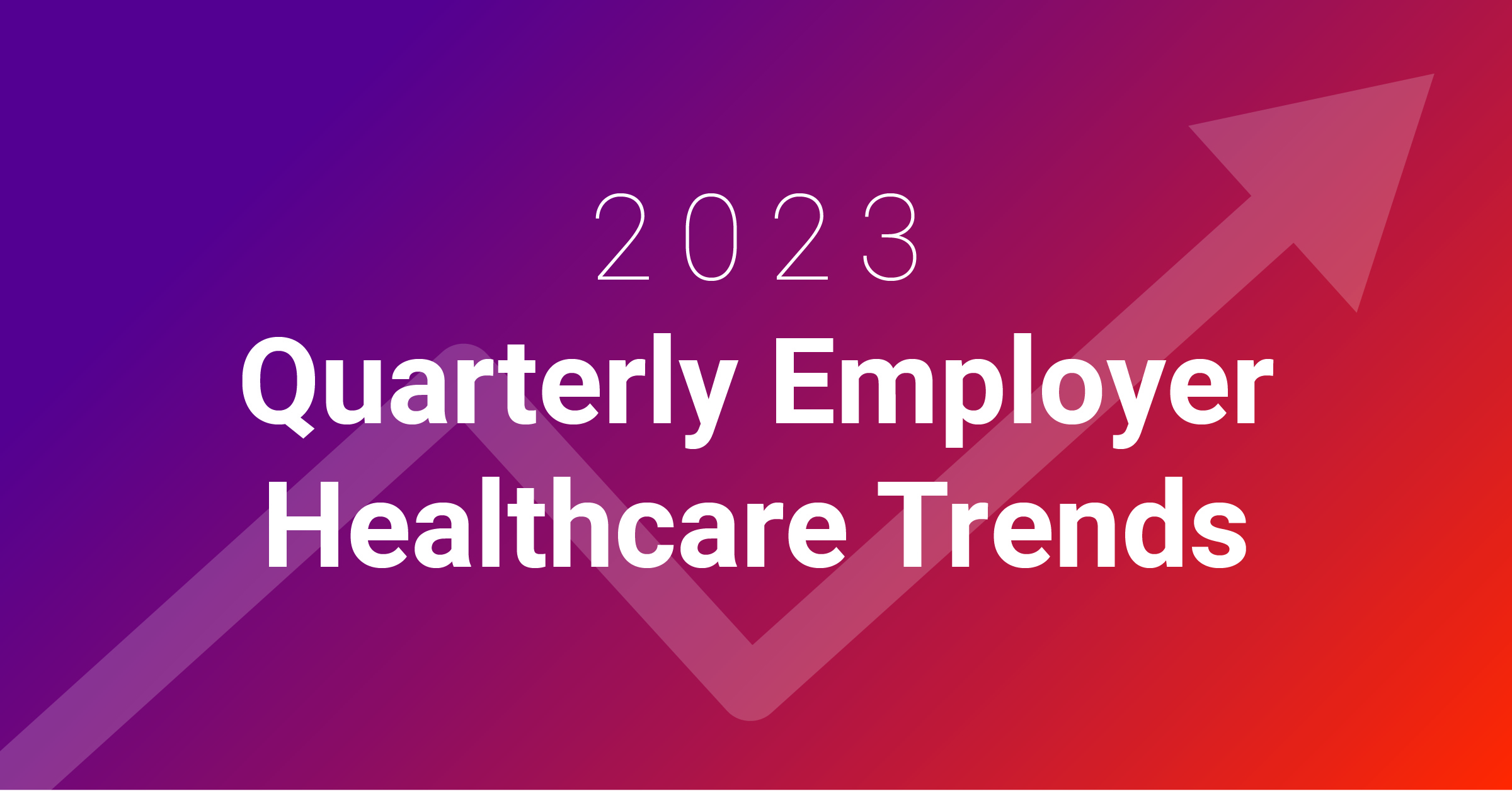As employers think about the future, there’s a sharp focus on offering the right benefits to attract and retain talent, while helping employees live happier and healthier lives.
From using technology to enhance convenience to improving how employers communicate employee benefits, check out some of the top healthcare trends for Q3 2023.
Employees Expect Technology Convenience, But Want Options for Healthcare
The pandemic didn’t just disrupt the way employees engage with healthcare, it changed the way they feel about the role technology plays in their healthcare delivery.
A recent Huron study found 70% of consumers are open to a virtual health visit at home, up from 41% pre-pandemic.
“Many people are working a hybrid schedule, so virtual care still makes sense,” says Heather Weeks, Vice President of Product Management at Marathon Health. “I suspect many of the people who tried virtual care for the first time during the pandemic realized that it was not just acceptable, but preferable, and are now sticking with it.”
The same study showed two-thirds of consumers want the option to use technology to schedule appointments and communicate with health providers, while nearly 75% are open to using wearable devices to report health data to their care team.
“The Marathon Health app makes it really easy for members to schedule an appointment, communicate with their care provider, manage prescriptions, participate in wellness challenges and more,” Weeks says. “They can sync their FitBit or another device to the app so that they track steps, sleep, fitness, water intake, heart rate and other health-related data points. One of our employees just told me how convenient it was when she was participating in the company’s walking challenge. It synced her steps and monitored her progress! Healthcare technology must live up to consumer expectations.”
Larry Boress, Executive Director of the National Association of Worksite Health Centers says when you offer a worksite health center or other service for your employees, you need to offer multiple ways people can get access. “The ability to have these digital approaches, the remote monitoring and the ability to see someone in person all being connected really makes for more integrated, holistic care,” he says.
To accommodate the modern workforce, Boress says employers should consider what he calls a “click and mortar” strategy, meaning employees have the convenience to schedule a virtual appointment, or meet with a physician or therapist in person.
Providing virtual offerings for services like behavioral health, diabetes management and health coaching doesn’t just improve convenience, it also reduces barriers and addresses social determinants of health.
“We’re seeing a lot of engagement with virtual behavioral health,” Weeks says. “We’ve come a long way with mental health in the employer space, but there still can be a stigma around it. Virtual allows some people who might otherwise experience some challenges to really open up. The extra space of virtual allows that connection and vulnerability to happen.”
There’s No Such Thing as ‘Over-Communicating’ Your Healthcare Benefits
When employers see low utilization of their health benefits, it can often be tied back to a lack of communication and overall awareness. Employers often make the mistake of only mentioning benefits during new-hire orientation, not allowing their healthcare partners to communicate with workers directly and utilizing too many disconnected vendors.
There’s no such thing as over-communicating health benefits. In fact, employers should design robust communication strategies to continuously market and promote their health benefits.
“Your employee marketing should be an omnichannel approach that includes email, home mailers, text messages, portal messages and targeted outreach,” says Shannon Isom, Senior Director of Engagement at Marathon Health. “For employees who work on their feet or don’t use a computer, maybe it’s a sign in the bathroom or CCTV footage in the breakroom.”
Communicating employee health benefits should never be a one-and-done exercise, but rather a year-round strategy in partnership with your benefits partners. Remember, some employees might not be aware of everything you offer.
For example, if you provide free or low-cost medications through an employee health center, remind them. If employees can earn incentives for completing a biometric screening or physical exam, communicate these benefits frequently via webinars, health fairs and awareness campaigns. If employees have access to remote monitoring devices for hypertension or blood sugar, make sure they know how to get started.
“We like to work with the client to set up a calendar of events or an engagement strategy tied to health services for the month,” Isom says. “For example, February is Heart Health Month. So, we’ll set up tables for blood pressure screenings and actually take blood pressure at the employer’s worksite. It’s a chance to meet the health center staff and see a friendly face.”
Boress says communication comes down to helping workers build up their health benefits literacy, so they understand the tools available to them. Employers should also consider the generational divide when they communicate health information, and ensure their health center partner does the same.
“There’s never one right way to communicate or to deliver care,” he says. “You need to segment your population and identify the best way to engage people, understand how they want to receive care and the type of technology they’re comfortable using.”
Employee advocates can also provide an effective way to promote health benefits. Showcasing an employee success story or testimonial offers an extra layer of authenticity.
“We like to hear straight from the member’s mouth, because that’s going to be the most impactful, whether it’s the CEO or it’s Joe from the assembly line,” Isom says. “It’s about sharing their story and what they achieved with the help of the health center team. We like to use their words, of course with their permission.”
When the ‘Shiny New Benefits’ Aren’t Shiny Anymore
Many employers launched new health benefits during the pandemic to better attract and retain workers in a highly competitive time. But in the rush to compete for talent, employers didn’t always provide benefits employees want or use.
“During the pandemic, people were throwing a lot of things out there and not necessarily looking to measure them,” says Nikki Wallace, Senior Consultant of Benefits & HR Consulting at Gallagher, who sat in our recent webinar roundtable on helping HR leaders strategize for 2024 and beyond. “They’re now finding out people may not be using these benefits, so how do they ensure the programs they offer are really valued by their people?”
Rather than chasing the latest shiny new object, employers need to listen to employees to understand what they need and value in health benefits. With this information, employers can provide the right benefits, define their success metrics and ensure budgets go toward services employees want and use.
Wallace suggests employers also work with their benefits consultants to ensure existing and new benefits align with employees and company culture. If data shows your benefits aren’t improving the health of your employees, it may be time to re-evaluate your offerings, too.
Satisfaction is Key for Better Health Outcomes
The ultimate goal of providing health benefits is to keep employees healthy and enhance their quality of life. Yet, employees won’t utilize a worksite health center or other benefits if they have a bad experience or don’t see health improvements. As a result, health outcomes decline while costs go up.
A Huron study found healthcare consumers rank accurate diagnosis and treatment plans that get results as the top driver of a satisfying and quality experience, followed by trust and respect. Again, it comes back to understanding how employees feel about their quality of care, the experience and their relationship with their providers.
According to Marathon Health member data, 98% of patients report feeling satisfied or very satisfied with their services. Of the members who engage with the services, 59% of high-risk members made improvements on quality measures. The data also shows a 23% reduction in emergency department visits and 19% reduction in hypertension for engaged members.
Wallace says employers should conduct frequent pulse surveys and focus groups, and also monitor employee engagement rates with existing benefits to better measure employee satisfaction. She adds employers must not only be mindful as they craft employee surveys to ensure they ask the right questions, they must also be willing to act on any topics proposed in the survey.
You might also like
Subscribe to our newsletter and stay on the cutting edge of worksite healthcare.










